Hippopotamus
The hippopotamus (Hippopotamus amphibius), also called the large hippopotamus, is a species of mammal in the hippopotamus family and the order of even-toed ungulates. Within the genus Hippopotamus, it is now considered the only member. After the elephants and next to some representatives of the rhinoceroses and the giraffes, it is one of the largest land-dwelling animals. Special characteristics are the large, barrel-shaped and largely hairless body, the short limbs and the massive head with a wide mouth in which the incisors and especially the lower canine teeth are enlarged. As an adaptation to a partly aquatic lifestyle, the ears, eyes and nostrils are located very high up on the head. The range of the hippopotamus includes sub-Saharan Africa and is in part highly fragmented. Its main habitats are open landscapes and woodlands, but it is largely absent from tropical rainforest. Originally, the hippopotamus also occurred along the Nile up to its estuary delta, which is where the common name hippopotamus comes from. It is now extinct along the entire lower reaches of the Nile, but populations still exist along the White and Blue Niles.
The animals stay in water bodies during the day. Their main activities begin at dusk or at night, when they leave the resting places and go to their grazing grounds on land. They are predominantly herbivorous, feeding on a variety of grasses, less commonly on aquatic plants and on scavenged crops. In some circumstances they may also eat carnivorous resources. The hippopotamus exhibits complex social behavior. Different, but mostly unstable group formations occur. Thus, associations of female animals with their offspring, groups of male individuals as well as mixed associations are formed. Solitary males are often territorially bound and defend their mating privilege as long as they are in their territory. Communication is varied and consists of a repertoire of gestures, of which the wide-open mouth is the best known, and vocalizations. The latter have been little studied. The animals use them both under water and on land. Mating and the birth of the usually single young take place exclusively in the water, as does suckling. About eight months pass between the sexual act and the birth of the female animal. Due to its group life and the long period it spends in the water, but also its feeding behaviour, the hippopotamus has a great ecological influence on its immediate environment.
Representatives of the genus Hippopotamus probably first appeared in the Lower Pliocene, about 5 million years ago. Its origin is in Africa, where it has a rich fossil record with numerous species. In the course of its phylogeny, it also reached the Near East and Europe. The latter was probably colonized by the genus several times, since from here, in addition to individual more primitive forms, remains of the actual hippopotamus also exist. The presence of the animals, however, was largely confined to the warm periods of the Pleistocene. On some islands of the Mediterranean Sea dwarf forms developed, likewise dwarfed hippopotamuses have survived from Madagascar. Overall, the systematics of the fossil forms of Hippopotamus is considered to be in need of revision.
The first scientific description of the hippopotamus as a species and genus was in 1758. Prior to that, it was mainly mentioned in travel reports. An attitude in the modern western world is not documented before 1850. However, numerous accounts by ancient scholars have survived, dating back at least to the 6th century BC. In prehistoric times, the animals served as a source of food and raw materials. Numerous rock paintings in northern and southern Africa bear witness to their importance, especially since the end of the Pleistocene and the Holocene. In ancient Egypt, the hippopotamus was worshipped in the form of the goddess Taweret. According to the beliefs of the time, the animal possessed both caring and destructive powers. At this time, numerous statuettes were created, which were placed in the graves of the deceased.
The population of the hippopotamus, estimated at 115,000 to 130,000 animals, is considered endangered. The main threats are habitat destruction and hunting, which is sometimes intensive. There is also an intensive trade in the animals' teeth. The hippo's dependence on water also leads to conflicts with the local population. According to a widespread opinion, the hippopotamus is one of the most dangerous animals for humans, but there is no statistical basis for this. Outside the hippopotamus' native range in Africa, a population has existed since the 1990s on the Río Magdalena in South America, which emerged from an abandoned livestock farm.
Features
Habitus
The hippopotamus is a large and heavy representative of the even-toed ungulates. Several studies have been carried out on individual populations. For example, over 190 animals from Kruger National Park in South Africa were found to have a head-torso length of 259 to 350 cm, a shoulder height of 110 to 172 cm and a weight of 955 to 1999 kg. Male individuals tend to be larger than females. The measurements of the former average 312 cm, 150 cm and 1546 kg, while those of the latter average 299 cm, 144 cm and 1385 kg. In Uganda, according to measurements in the 1960s, the weight of males averages 1536 kg with a maximum of 2065 kg, and that of females 1386 kg and 1716 kg respectively. Similar data are available for studies on about 440 animals in the Murchison Falls National Park in Uganda from the 1950s. Here, male individuals had an average weight of 1475 kg and a maximum weight of 1895 kg, females of 1360 kg and 2018 kg. For several hundred animals from the Luangwa River basin in Zambia studied in the 1970s, shoulder height for male individuals was 130 to 147 cm with weights of 1027 to 1799 kg, and for females correspondingly 123 to 151 cm and 891 to 1565 kg. The largest known individual, a bull, weighed 2660 kg. The body has a characteristic barrel-like shape with a torso circumference of a good 300 cm, the limbs are short and strong. They end in four forward projecting toes each, which are equipped with broad hooves and connected with partially formed webbed feet. The tail is short and broad, its length is given as 40 to 56 cm. The head is massive and broad. As a typical adaptation to a semi-aquatic life, the ears, eyes and nostrils are located very high up on the head. Compared to the large head, the ears are very small. The nostrils can be closed by muscular valves. The body coloration varies between dark reddish brown on the back and flesh-colored on the underside, but it varies greatly from individual to individual. The apparently naked skin is covered by short hairs, their density is 20 to 30 per 100 cm² on the back, thinning to about half on the sides, on the belly the hair cover is even sparser. A thin hair fuzz is formed also in each case at the head-sides, the lips and at the neck. Some bristle-like thicker hairs are found on the mouth and tail.
Skull and dentition characteristics
The skull of the hippopotamus is large and massive. It is 63.5 to 77.0 cm long in males and 36.8 to 48.3 cm wide at the zygomatic arches. The skull is between 17.4 and 22.2 cm high. In females, the measurements are somewhat smaller and are correspondingly 57.7 to 69.0 cm, 32.7 to 41.1 cm, and 16.7 and 20.2 cm. The entire anterior cranial section with the rostrum is more extensively developed than the posterior. The rostrum widens considerably towards the front, which is due to the dental compartments of the canines. At the level of the premolars it again narrows markedly. Behind it the small, roundish skull is set off. The broad rostrum, the strong constriction in the middle section and the somewhat broadened posterior part give the skull the shape of an hourglass when viewed from above. Strong bony ridges appear on the upper skull, these include the parietal crest and the superocular ridges. The former is massive and rises, due to the shape of the skull. In the pygmy hippopotamus (Choeropsis liberiensis), however, it is downward. The latter is caused by the high position of the orbits on bony pedestals. As a result, the upper edge of the orbit is clearly above the frontal line, the distance can be up to 5.5 cm, while in the pygmy hippopotamus it is smaller. In addition, a prominent pit is found on the anterior margin of the orbits, which is one of the defining features of the genus Hippopotamus. As another important feature, the frontal bone is not in contact with the nasal bone, as a greatly enlarged lacrimal bone is interposed. The widely projecting zygomatic arch serves as an attachment point for massive masseter and temporalis muscles.
The lower jaw is also extremely robustly designed and, as a unique feature, heavier than the skull. Its length varies from 39.8 to 62.0 cm, its height below the second molar from 10.9 to 14.3 cm. A striking feature is the extremely posteriorly displaced position of the articular process, which articulates with the skull near the occiput. This allows the wide mouth opening of the animals up to 150°. The angular process at the posterior end of the mandible extends downward in a hooked shape. The dentition consists of 36 to 40 teeth and shows the following dental formula: 
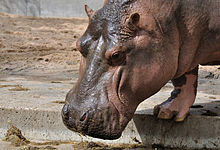
The broad head of a hippopotamus
_grazing_(12033127823).jpg)
Hippo in Kruger National Park in South Africa

Skull of a hippopotamus

Chewing surface of the back teeth
Lifestyle
Territorial and social behaviour
Adaptations and physiology
The hippopotamus lives semi-aquatic and is well adapted to this environment. Favouring features for this include the nose, eyes and ears positioned very high up on the head, so that the animals can keep them above the waterline when swimming. When diving, a reflex closes the slit-like nostrils and ears, and the breathing rate is then around six puffs per minute. The short limbs are to be regarded as a functional modification, as are the compact and partly compacted bones, the medullary tubes of which are filled with cancellous material. The more massive forelegs carry the greater part of the body weight, which is beneficial for locomotion in water, among other things. However, the hippopotamus also lacks some typical characteristics such as a streamlined shape, in addition, the front and hind legs show only limited special swimming characteristics, for example in the form of the partially formed webbed feet.
The epidermis of the skin is very thin, sometimes only about 1 mm as on the back. Due to numerous nerves it has a high sensitivity. It can be very easily injured by branches and twigs of bushes, but heals quite quickly. It also breaks quickly by drying on land and must therefore be kept moist. The dermis, on the other hand, is very thick. On the back and sides it reaches 60 mm, on the head, neck and belly it becomes thinner. In total, the skin weighs about 270 kg, which is about 18 % of the body weight of an individual, and covers an area of 10 m².
No sweat glands are developed, but special subdermal skin glands secrete an alkaline fluid with a pH of 8.5 to 10.5, which protects the animals from dehydration. These excretory organs are distributed over the body surface in a dense network of one gland per square centimeter, have a lenticular outline, and each has two glandular ducts. The initially colorless fluid turns reddish within a few minutes and later brownish. Components of this fluid are two non-benzoid aromatic pigments, a red one called hipposudoric acid and an orange one called norhipposudoric acid. Both act as sunscreens, absorbing UV rays, as well as antibiotics against various pathogens. The reddish glow used to lead to the assumption that the hippopotamus was sweating blood.
Another function of the secretion concerns thermoregulation, which takes place mainly through the skin. It takes place via water evaporation, which is very intense in the hippopotamus compared to other mammals, especially when the skin is wet and covered with the glandular fluids. The body temperature is around 36 °C and fluctuates very little on land. As a rule, the animals avoid heat stress and therefore stay in the water during the day. However, this also includes various sunbaths, which can vary in length depending on the season and ambient temperature.
Activity rhythm
The hippopotamus is largely crepuscular and nocturnal. It spends practically the whole day sleeping or resting in the water or near water, which can take more than twelve hours. Preferred water depths for resting sites range from 1.3 to 1.5 m. Greater activity in the water unfolds in the late afternoon and early evening between 4:00 and 7:00 pm. At dusk, the animals move ashore and migrate to their grazing sites. Feeding lasts up to six hours. Rhythms are largely dependent on weather and season, as animals may linger out of water longer in wetter conditions, sometimes resting in their grazing grounds or visiting them several times. For animals from the Boye wetlands near Jimma in Ethiopia, the distribution of activity was 51.2% resting, 34.2% migrating, 19.6% feeding and 3.7% mating. Bulls rested longer on average than cows, which invested more time in migration and feeding.
Social organization and use of space
Extensive studies on the social structure of the hippopotamus have taken place in the Queen Elizabeth National Park in Uganda, the Masai Mara in Kenya or the Okavango Delta in Botswana, among others. The social behaviour of the hippopotamus is variable. According to studies in the Masai Mara, a 2800-strong population was made up of 8% bulls, 36% cows and 56% juveniles, with almost half of these being nearly adult individuals and half newborns. The hippopotamus occurs solitary or several individuals join together to form a group, the average size of which in the Masai Mara is around a dozen animals. There are different forms of group formation, on the one hand those of female animals with their offspring, on the other hand bachelor groups with male individuals. However, the boundaries are not clearly defined, as representatives of the opposite sex can often be found in the respective groups. None of the associations are stable, they are rather loose associations of animals in favoured places. They may number up to 200 individuals depending on the attractiveness of the area. In rainy seasons, existing groups often split up, resulting in fewer animals in a group than in dry seasons. The only lasting relationship is between the mother and her offspring, which lasts for several years.
Solitary bulls usually establish their own territory, their social organization is based on territoriality. Territories often include the shorelines of rivers and lakes. They may extend 50 and 100 m as on the Ishasha River or 250 to 500 m as on Lake Edward, both in Queen Elizabeth National Park. Boundaries shift over the year as there is a dependence on the population density of a region. In addition, natural factors such as changes in the flow of a river or the course of the lake shore as a result of drought or rainfall or flooding play a role. Often an individual claims its territory over a long period of time. Individual observations have been made over four and a half to twelve years, and it is sometimes assumed that a single animal occupies its territory for its entire life. The boundaries of a territory include one or more action areas of group-living individuals. At the same time, territories and action areas are not identical. In the Ruaha National Park in Tanzania, larger, almost adult juveniles use much more extensive action areas, which exceed the size of the territories of dominant bulls by a factor of three. The necessary migrations of sometimes more than 4 km are probably undertaken to avoid intra-species conflicts, especially during the dry seasons when the individual groups move closer together.
The claim to a territory is expressed by the presence of the male animal, his dominance behaviour and defecation. The excrement, which a bull distributes by wagging his tail, piles up to larger mounds with an area of several square meters. These mounds, however, do not mark the actual territorial boundaries, but rather serve as landmarks. They also do not prevent foreign bulls from entering a territory, sometimes they stimulate another individual to defecate there as well. Neighbouring bulls sometimes defecate ritualistically at the same time in the water and look at each other or in the opposite direction with their heads raised high and their ears pointing forwards, which in each case signifies dominance.
Like other hippos, a bull goes inland at night in search of food, thus leaving its territory. If a bull crosses its own territorial boundaries, it loses its dominant position and acquires the status of a subordinate animal in relation to the owner of the other territory. Generally, however, the hippopotamus is peaceable towards all conspecifics, which includes bulls, provided they acknowledge the dominant animal's procreative prerogative. Sometimes bachelor groups with an individual size of up to 100 animals can stay in the territory of a territorial bull. Denser crowding of animals at individual water points, as is often the case in the dry season, can lead to increased aggression, directed at either sex and age group, but usually involving little physical action. Fights between neighboring animals are ritualized and conducted head-on. They are sometimes associated with the splashing of water, which is meant to indicate a boundary. Real fights, on the other hand, take place in a sideways position. Each animal then tries to hit the side of the opponent with the help of its large canine teeth. Despite the overall thick skin, this can lead to serious injuries and even death.
The grazing areas, which are mainly visited at night, are sometimes several kilometres away from the ancestral watering places. In contrast to the territories of the bulls, the feeding grounds are not monopolized. They are therefore shared and not defended. The walk to the grazing areas and the food intake take place individually or in mother-young animal groups. With the exception of the latter, there is hardly any social interaction, so that each individual eats alone. In the Masai Mara the animals move up to 1350 m away from their watering place, in the Kruger National Park in South Africa the distance can be up to 4.5 km. The distances are mostly dependent on the productivity of a landscape.
Locomotion and communication
Although the hippopotamus spends much of its life in water, it is not a good swimmer. Most of the time, it runs along the bottom of a body of water or lets the water carry it; the mode of locomotion is sometimes called "swim-running". In doing so, the hippopotamus uses a type of gallop with relatively extended jumping phases that last longer than the contact phases with the bottom. During each jump, an animal covers between 1.0 and 2.4 m. The speeds achieved are 0.2 to 0.6 m per second. Dives can reach a duration of 30 minutes. On land, however, the hippopotamus moves forward at low speeds in a kind of passing gait, usually with three feet touching the ground at the same time, thus stabilizing the massive body. Only in a short sequence does a bipedal phase occur. Higher speeds are achieved by a trot with diagonal leg movement. Maximum speeds during flight or attack are around 30 kilometres per hour. The hippopotamus is therefore relatively agile despite its massive physique.
The intra-species communication of the hippopotamus is multifaceted. This includes especially the body language and gestures. Dominant bulls are often recognizable by their ears, cows and subordinate animals by their ears being laid back. The dominant behaviour is connected with a raised head and a curved back, which expresses a greater massiveness. One of the best known gestures is the open mouth. Here the head is thrown back so that the forehead line is at right angles to the back. Dominant animals hold this gesture for up to eight seconds. However, the open mouth is practiced by almost all members of a group, including juveniles, and occurs to a greater extent in the evening before going ashore. Possibly this behaviour is an expression of excitement. When attacked, the animals open their mouths only partially. Submissive behaviour is shown by a lowered head, tail wagging and lip smacking. On land it already starts at a distance of about 100 m from the opponent, sometimes subordinate animals crawl the last meters and then sniff the genital region of the territorial bull. In the water nose contacts play a role, sometimes the subordinate individual remains for hours in the environment of the dominant animal. Sometimes defecation also occurs, although the meaning here is not clear.
Little information is available about the vocalization of the hippopotamus. It is most often perceptible at the time of the strongest activity in the water, which takes place in the late afternoon. On land, it is rarely seen. As a semi-aquatic animal, the hippopotamus is capable of communicating with conspecifics both on land and underwater by means of vocalization. Normally, communication using both media simultaneously encounters difficulties because sound waves break at the boundaries. Only about 4% of all vocalizations occur exclusively through the air. In contrast, the hippopotamus produces nearly two-thirds of its vocalizations underwater. They are difficult to perceive on the surface and require little air for their modulation.
The function of the sounds is not clear in all cases. Crying sounds, which last only a short time and are sometimes combined with single clicking sounds, are possibly associated with aggressors. In contrast, cawing sounds are emitted when there is general alarm or alertness, or serve as contact calls, for example in murky water. They consist of a series of about half a dozen pulses, each lasting mostly 2 milliseconds and reaching frequencies of 600 to 1800 Hz, in maximum also 9000 Hz. During this process, the pitch may remain the same or change, possibly expressing variable motivations. During social interactions, click sounds are emitted, which can be highly variant and occur in both broadband and narrowband ranges. These are also composed of multiple pulses that are shorter than those of cawing sounds. Broadband clicks occur in frequencies up to 7800 Hz, whereas narrowband clicks rarely exceed 2000 Hz.
Almost a third of the hippopotamus's sounds are amphibious in nature, and thus spread through the water and air. For this form of communication, the animals are in a semi-submerged position with the eyes and nostrils above, the mouth and throat under water. The air needed for this is forced through the nose by means of the pharynx for above-water communication, and the larynx activates the skin and fatty tissues of the throat for underwater communication. In a fully submerged position, the sound modulations are partially associated with an ascending air bubble. Perception occurs for airborne sounds by means of the ears, and for waterborne sounds probably by means of the bone conduction of the lower jaw. The sound waves propagate at different speeds due to the varying density of the media and have very different ranges. In air they are slower with lower maximum frequencies (around 210 Hz), in water faster and with higher maximum frequencies (above 2000 Hz). In addition, the sound pressure is stronger in water, but the higher density of the wet medium leads to a lower intensity of the sounds.
Amphibious sounds are mostly used by the animals when disturbed, such as in a fight or in the presence of lions, which are a danger to young. In addition to the aforementioned croaking, clicking and crying, hippos can also emit screams as well as variable growls, grunts and snorts, including a fluttering nose. Usually, the dominant bull calls first. The group responds to this signal, stimulating neighboring aggregations. Through the air, responses may extend over several territories to a distance of 3.2 km. Underwater, neighbouring groups usually remain involved, so that the greatest dispersal is around 500m.
Nutrition
The hippopotamus is a herbivore. It mainly consumes grasses. Studies in the Boye wetlands in Ethiopia have identified 26 species, among which Eriochloa with a share of almost 12%, bulrush and hen millets with over 9% each and dogtooth grasses with over 8% are among the favoured plants. In the Masai Mara, about a dozen grass species are documented as food of hippopotamus. These include Themada, Sporobolus and Andropogon as well as love grasses. In Queen Elizabeth National Park, over 30 different grass species have been identified as being consumed by the animals. Dogtooth grasses are of particular importance, but genera such as Chloris, Heteropogon, Sporobolus and Themada are also represented in high numbers. Occasionally the hippopotamus eats individual herbaceous plants such as members of the genus Alternanthera. This also applies to fruits such as those of the liverwurst tree. Sometimes the animals also eat various aquatic plants, including water lettuce. Similar observations have been made in southern Africa, where water lilies, salads and spawning herbs are part of the diet. Only a few studies on the hippopotamus' diet are available from central and western Africa. In the Loango National Park in Gabon, field studies revealed a total of nine plant species, of which the sweet grass Paspalmum had the highest proportion (81%), followed by Axonopus and Stenotaphrum. In addition, individual butterfly weeds and aquatic plants such as pennywort have been documented. With about nine preferred plants in W National Park in Niger, the number is similarly low. Dayflowers, chicken millet and rice dominate here. Animals regularly visit arable land with rice, maize or teff, sometimes also banana plantations, and thus plunder crops. Isotope examinations of individuals from different regions of Africa largely agree with the observations. According to the data, a large part of the diet consists of C4 plants, with higher amounts of C3 plants in regions with closed vegetation such as central Africa. Furthermore, according to the data, the composition can vary regionally as well as seasonally with a high proportion of C4 plants in the dry parts of the year and a mixed diet of C3 and C4 plants in the humid areas. Individual reports indicate that the hippopotamus occasionally eats carrion and meat from animals it has killed itself, which includes its own conspecifics. It has rarely been observed, but in principle it is capable of digesting meat.
In general, the hippopotamus is an opportunistic herbivore that prefers individual plants but consumes them without pre-selection of specific vegetative parts. The large and thick-lipped mouth and the special lower jaw suspension prevent a fine selection of food. Therefore, the animals seek areas of frequent occurrence of their favored plants and then eat more extensive areas empty. The amount of plants consumed is higher the farther the grazing sites are from water points. Overall, the feeding strategy of the hippopotamus, with its restriction to a specific part of the day and distance from ancestral action areas and territories, differs from that of other large herbivores such as elephants or rhinoceroses, which forage for long periods of time, roaming widely. Grass is usually pressed between the lips and torn off with a head movement. The incisors and canines have no function in foraging, but the former are sometimes used for digging. Feeding occurs mostly at night and may take several hours. If the plant quality is poor, the hippopotamus also eats during the day. Per day an animal takes between 20 and 45 kg of food. In terms of dry matter, this corresponds to 0.9 to 1.3% of body weight. The stomach holds an average of 34.9 kg in males and 37.4 kg in females, representing 12.8 and 15.2% of body weight, respectively. The hippopotamus has a four-chambered stomach developed convergently with ruminants. This has two blind sacs in which the food is decomposed by microorganisms. However, they do not ruminate. The passage time of the food is relatively long, which allows an efficient utilization of the rather nutrient-poor grasses.
Reproduction
Mating takes place throughout the year. It takes place in the water, the female is submerged most of the time and only comes to the surface to breathe. There can be up to six matings per night. Sometimes the cow will seek out two or more territories for further mating activity after a successful mating. The gestation period is about 227 to 240 days. At least in some regions, seasonality in reproduction can be seen. In Uganda, for example, most births occur in October and April, the periods of the year with the most rain. Similarly, in South Africa, the vast majority of young are born in the wet months of October to March. Similar observations have been made in Zambia.
Shortly before giving birth, the expectant mother separates from the group. The birth takes place in shallow water, in case of disturbances the cow seeks deeper water. Usually a single young animal is born, twins are rare. Newborns weigh between 25 and 55 kg and can walk immediately after birth and push off from the water bottom to the surface. They suckle in the water, the offspring activating the mother's mammary glands with its tongue. Presumably the mother injects a part of the breast milk into the mouth of the young by muscle contraction, similar to what is known from whales. The mother animal is very caring. It lets the offspring ride on its back in deeper water and defends it vehemently against predators and conspecifics. This happens particularly aggressively in the first ten days. During this time the mother hardly takes any food. Only then does she begin to feed on the riverbank during the day, while the young rests nearby. After several weeks, mother and young wander together at night to the more distant grazing grounds. The young remains hidden in the bushes while the mother grazes. The young consume their first solid food at around six to eight weeks. After about six to eight, sometimes twelve months, the young are weaned. The growth phase is initially the same for both sexes, slowing down from around 24 years of age for females, while male individuals can increase in size throughout their lives.
Sexual maturity occurs in male individuals at seven to eight years of age, as determined by the size of the testes, although spermatogenesis may begin as early as two years of age. In females, the period is usually about seven years due to the size of the follicles, but single individuals reached this as early as three years. The first reproduction usually takes place much later. In the Kruger National Park it was determined at about eleven years of age, in Uganda and Zambia sometimes not until 20 years of age. The differences are probably due to the population density and the quality of the food supply. Animals in human captivity can sometimes reproduce at just over two years of age. Males are sexually active throughout their lives.
The birth interval is about two to three years. The sexual cycle lasts about 50 days, with estrus lasting two to three days. The sex ratio at birth is 1:1. There is evidence that cows are sexually mature again shortly after birth (postpartum estrus), as about 25% of the females studied were both pregnant and lactating. The birth of a new young does not break the existing bond with the older offspring. Some females were observed with up to three young of different ages. In the marching order, the youngest animal directly follows the mother, the oldest brings up the rear. Sometimes infanticide of young animals by bulls occurs. Under certain circumstances this happens when a dominant animal takes over a new territory and thus wants to guarantee its reproductive success, similar to what is known in lions. On the other hand, killings of cubs have often been observed in the dry season, so external stress could also be an important factor. Cubs are thus endangered up to 50 days of age. According to individual observations, mother animals continue to occupy themselves with a dead young for several hours, defending it against predators and bringing it ashore. The hippopotamus is one of the few ungulates that show such behaviour. Wild hippos live 30 to 40 years. Animals in captivity can reach over 50 years, the highest known age of an animal was 61 years.
predators, commensals and parasites
An adult hippopotamus has few natural enemies; occasionally lions will prey on an adult, but these sporadic actions have no impact on the local population. Young animals occasionally fall prey to hyenas or also to lions. As a rule, mother animals defend their offspring extremely aggressively. The Nile crocodile is also capable of snatching young and possibly even adult individuals. In a shared water body, hippo groups usually do not tolerate crocodiles in the immediate 2 m vicinity. On the other hand, crocodiles in turn avoid hippos and dive in close proximity. According to observations on the round in Zimbabwe, hippos also drive crocodiles away from their sunbaths. Exceptions here are the larger specimens from lengths of 3.5 m, which again were avoided by the hippos. As a rule, however, groups of hippos dominate those of crocodiles.
Often the hippopotamus occurs in association with various bird species. Known for this are the oxpeckers, especially the yellow-billed oxpecker is found in close proximity to the animals. According to research conducted in 2018, it was detected in 11.3% of all observations. Also of note would be the Cattle Egret, Lappet Starling, Piapia, and Blue-fronted Leafhopper. While oxpeckers predominantly benefit from parasitic infestation of their hosts, the frequent occurrence of cattle egrets is probably due to the overlap of shared habitats near water. In the water, carp fish such as members of the genus Labeo take over the role of oxpeckers and eat algal populations from the skin of the hippopotamus.
Parasites are numerous in the hippopotamus. Significant external parasites are found mainly in ticks such as Cosmiomma. A special feature is the flatworm Oculotrema, which attaches itself to the eyes. Sometimes two dozen individuals can parasitize on one eye and up to three dozen on a hippopotamus, also different generations occur on one host animal. Internal parasites are, for example, the couple fluke and the genus Fasciola, both of which belong to the sucking worms and infest the blood and liver, respectively. Threadworms include Toxocara, Stephanofilaria, Cobboldina and Hippopotamenema. In addition, the hippopotamus is susceptible to rinderpest and anthrax. An anthrax outbreak in 1987 in Zambia claimed the lives of over 4000 animals, and another in 2004 in Uganda killed 300 individuals. Other disease-causing microorganisms include coccidia such as Eimeria, bacteria such as Brucella or Salmonella, and flagellates such as trypanosomes.
Ecological impact
As a large herbivore, the hippopotamus exerts a lasting influence on its immediate environment. It competes for food with some other grass-eating mammals, which can lead to ecological interactions. In Queen Elizabeth National Park, waterbuck numbers decrease when hippo are numerous and increase again when hippo population densities decrease. The animals often graze on short-stemmed grasses, encouraging grass species that are preferentially eaten by them but avoided by waterbucks. The preference for shorter grasses and their mass grazing results in a typical "hippo lawn" that is spatially confined. In combination with overgrazing and trampling of the area, rainfall sometimes leads to massive erosion, especially on the banks of the rivers. This also applies to the paths created by the daily repetitive migrations of the hippo, the so-called "Hippo Trails". These sometimes cut up to 1 m into the bedrock of the river and lake banks, or are gorge-like on steeper slopes. Often these are used by other, smaller animals. In the Okavango Delta, but also in the Ngorongoro, new water veins are created in this way.
The grazing activity of hippopotamus and other large herbivores such as elephants and rhinos can cause a severe decline in local vegetation, resulting in erosion, if the population is dense enough. Keeping landscapes artificially open reduces forest cover and promotes grasses preferred by the hippopotamus. However, in some circumstances, a feedback effect occurs when populations collapse. This was observed in Queen Elizabeth National Park, where, triggered by civil unrest and associated more intensive hunting, a large proportion of the resident large mammals disappeared between the years 1960 and 2000. This caused a greater spread of forest and bush communities. As a result, the remaining local hippos no longer had enough grasses at their disposal, which is why they increasingly switched to herbaceous plants. In the course of this process, their share of the diet increased from less than 20% in the 1960s to up to 45% in the 1980s and 1990s.
The frequent discharge of faeces and urine into water bodies sometimes also changes their chemical composition. This affects the fish community, which benefits from the input of nutrients. The carp genus Labeo, for example, feeds not only on algae on the skin of the hippopotamus, but also on its falling excrement. This also has a positive effect on the populations of various cichlid genera (for example Oreochromis, Sarotherodon and Tilapia). However, especially in the dry season when water levels are low and hippopotamus densities are high, severe oversaturation and oxygen deficiency sometimes occur. This then often results in a decline in the local fish and insect fauna, affecting both total numbers and diversity. This has been observed in Ruaha National Park and Masai Mara, among other places. The high demand for plants and defecation in the water also cause the hippo to contribute greatly to the silicon cycle. The animals bring about 400 kg of silicon into the Mara River every day, which probably accounts for about three quarters of the total amount. Silicon is important for numerous diatoms in the tropical lakes of Africa, which on the one hand are important carbon stores and oxygen producers, and on the other hand also form the basis of the food chain.
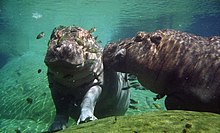
Hippos under water
.jpeg)
The ripped mouth of a hippopotamus
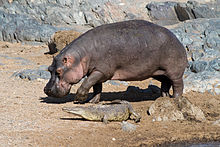
Hippo and Nile crocodile in the Serengeti National Park in Tanzania
.jpg)
Mother with young
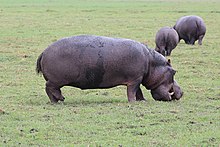
Grazing hippo in Chobe National Park, Botswana
.jpg)
Hippo group with young in Kruger National Park
_(13961802458).jpg)
Two fighting hippos

Dung heap of a hippo in Tsavo West National Park in Kenya
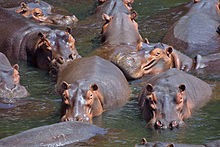
Densely packed hippos at the Luangwa in Zambia
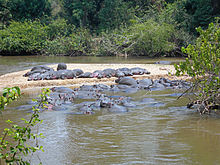
Hippos spend most of the day in the water, sunbathing on the sandbank is partly for thermoregulation
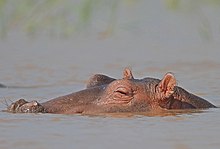
Nose, eyes and ears are very high up on the head and can thus be kept above the waterline
_(28371752360).jpg)
Hippopotamus with injured skin in the Ngorongoro in Tanzania
Questions and Answers
Q: What is the scientific name of the hippopotamus?
A: The scientific name of the hippopotamus is Hippopotamus amphibius.
Q: How many species in the family Hippopotamidae are still alive?
A: There are only two species in the family Hippopotamidae that are still alive.
Q: What is the third largest land animal in weight?
A: The hippopotamus is the third largest land animal in weight, with the elephant being heaviest and white rhinoceros being second heaviest but slightly smaller than a hippo.
Q: Is a hippo semi-aquatic?
A: Yes, a hippo is semi-aquatic which means it usually lives on land but spends much time in rivers and lakes.
Q: What does a hippo look like?
A: A hippo has a torso shaped like a barrel, a big mouth and teeth, an almost hairless body, short legs and great size.
Q: How fast can a hippo run?
A: Some hippos have been known to run at 30 km/h (19 mph) for short distances.
Q: How many estimated wild Hippos remain in Sub-Saharan Africa?
A: It is estimated that there are about 125,000 to 150,000 wild Hippos remaining in Sub-Saharan Africa.
Search within the encyclopedia